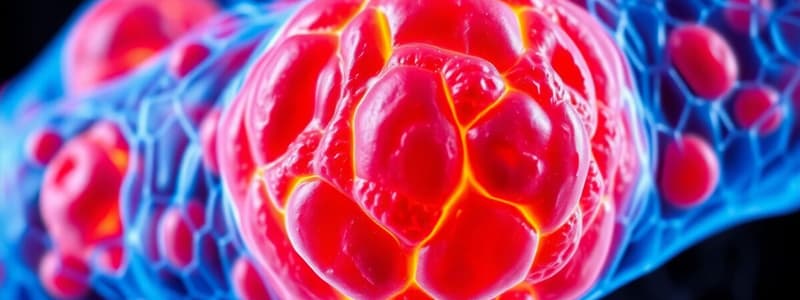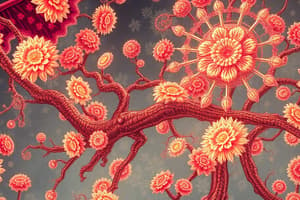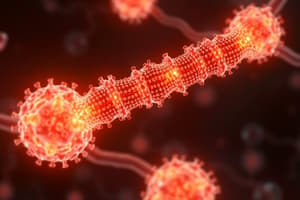Podcast
Questions and Answers
Which type of precancerous lesion is characterized by a change in the cellular type of tissues?
Which type of precancerous lesion is characterized by a change in the cellular type of tissues?
- Benign tumors
- Dysplasia
- Metaplasia (correct)
- Hyperplasia
Which of the following conditions is associated with the development of osteosarcoma?
Which of the following conditions is associated with the development of osteosarcoma?
- Chronic alcoholism
- Cirrhosis of the liver
- Paget’s disease of bone (correct)
- Hepatitis B virus infection
What is primarily indicated by hyperplasia in the endometrium?
What is primarily indicated by hyperplasia in the endometrium?
- Breast cancer
- Liver cancer
- Endometrial carcinoma (correct)
- Gastric cancer
Which method of tumor spread involves the formation of new blood vessels?
Which method of tumor spread involves the formation of new blood vessels?
Which viral carcinogen is linked to the development of cervical cancer?
Which viral carcinogen is linked to the development of cervical cancer?
Which of the following factors is considered a co-carcinogen related to environmental exposure?
Which of the following factors is considered a co-carcinogen related to environmental exposure?
Which type of cancer is associated with exposure to the carcinogen aflatoxins?
Which type of cancer is associated with exposure to the carcinogen aflatoxins?
What is the primary significance of tumor markers in oncology?
What is the primary significance of tumor markers in oncology?
Which tumor type is least likely associated with hereditary factors?
Which tumor type is least likely associated with hereditary factors?
Which of the following is not considered a chemical carcinogen?
Which of the following is not considered a chemical carcinogen?
Which type of tumor is classified as poorly differentiated?
Which type of tumor is classified as poorly differentiated?
What does the 'N' in the TNM staging system represent?
What does the 'N' in the TNM staging system represent?
Which of the following is an example of distant spread of cancer?
Which of the following is an example of distant spread of cancer?
What does tumor marker CA-125 primarily indicate?
What does tumor marker CA-125 primarily indicate?
Which of the following tumors is classified as locally malignant?
Which of the following tumors is classified as locally malignant?
What is the role of tumor markers in cancer management?
What is the role of tumor markers in cancer management?
What characterizes a well-differentiated tumor?
What characterizes a well-differentiated tumor?
Which spread mechanism involves tumor cells passing through blood vessels?
Which spread mechanism involves tumor cells passing through blood vessels?
Which factor is NOT a cause of death in malignant tumors?
Which factor is NOT a cause of death in malignant tumors?
What is NOT a characteristic of grade IV tumors?
What is NOT a characteristic of grade IV tumors?
Flashcards
Tumor Grading
Tumor Grading
The degree to which a tumor resembles its original tissue.
Differentiation in Tumor Grading
Differentiation in Tumor Grading
A well-differentiated tumor closely resembles its origin, while poorly differentiated tumors look very different.
Tumor Staging
Tumor Staging
Measures how far a tumor has spread from its original location.
TNM Staging System
TNM Staging System
Signup and view all the flashcards
Local Spread of Malignant Tumors
Local Spread of Malignant Tumors
Signup and view all the flashcards
Lymphatic Spread of Malignant Tumors
Lymphatic Spread of Malignant Tumors
Signup and view all the flashcards
Blood Spread of Malignant Tumors
Blood Spread of Malignant Tumors
Signup and view all the flashcards
Transcoelomic Spread of Malignant Tumors
Transcoelomic Spread of Malignant Tumors
Signup and view all the flashcards
Spread by Implantation of Malignant Tumors
Spread by Implantation of Malignant Tumors
Signup and view all the flashcards
Locally Malignant Tumors
Locally Malignant Tumors
Signup and view all the flashcards
Metaplasia
Metaplasia
Signup and view all the flashcards
Hyperplasia
Hyperplasia
Signup and view all the flashcards
Thyroid adenoma
Thyroid adenoma
Signup and view all the flashcards
Transitional cell papilloma
Transitional cell papilloma
Signup and view all the flashcards
Liver cirrhosis
Liver cirrhosis
Signup and view all the flashcards
Paget's disease of bone
Paget's disease of bone
Signup and view all the flashcards
Cryptorchidism
Cryptorchidism
Signup and view all the flashcards
Xeroderma pigmentosa
Xeroderma pigmentosa
Signup and view all the flashcards
Co-carcinogens
Co-carcinogens
Signup and view all the flashcards
Carcinogens
Carcinogens
Signup and view all the flashcards
Study Notes
Intended Learning Objectives
- Recall different types of precancerous lesions, carcinogens and cocarcinogens.
- Define tumor grade and stage.
- Describe the mechanisms of tumor invasion and metastasis, focusing on angiogenesis.
- Detail the different methods of malignant tumor spread.
- Define locally malignant tumors and provide examples.
- Explain the definition, examples, and importance of tumor markers.
- List the causes of death in malignant tumors.
Precancerous Lesions
- Metaplasia: Squamous metaplasia can lead to squamous cell carcinoma.
- Hyperplasia: Endometrial hyperplasia can lead to endometrial carcinoma. Mammary hyperplasia can lead to breast cancer.
- Benign Tumors:
- Thyroid adenoma can transform into thyroid carcinoma.
- Transitional cell papilloma can transform into transitional cell carcinoma.
- Other Precancerous Conditions:
- Liver cirrhosis leads to hepatocellular carcinoma.
- Paget's disease of bone leads to osteosarcoma.
- Cryptorchidism (undescended testes) can lead to seminoma.
- Xeroderma pigmentosa can lead to melanoma.
Co-carcinogens
- Factors that promote the development of cancer.
- Age: Increased exposure to carcinogens with age.
- Sex: Most tumors are more common in males.
- Diet: High fat diets are linked to colon cancer, and smoked fish is linked to stomach cancer.
Environmental Factors
- Cigarette Smoking: Linked to cancer of the tongue, larynx, lung, kidney, and urinary bladder.
- Alcoholism: Associated with cancers of the mouth and esophagus.
- Excess Sun Exposure: Linked to skin cancer.
Heredity
- Some cancers are inherited, including breast and colon cancer.
Chemical Carcinogens
- Beta-naphthylamine (paints): Linked to bladder cancer.
- Aflatoxins (aspergillus fungus): Linked to liver cancer.
- Nitrosamines (preservative substance): Linked to stomach cancer.
Viral Carcinogens
- Hepatitis B virus: Linked to hepatocellular carcinoma.
- Human papillomavirus (HPV): Linked to cervical cancer.
- Epstein-Barr virus (EBV): Linked to nasopharyngeal carcinoma and lymphoma.
Radiation Carcinogens
- Ionizing radiation: Causes leukemia.
- Ultraviolet rays (prolonged exposure): Causes skin cancer.
- Hormones (estrogen, androgen):
- Estrogen: Linked to breast and endometrial cancer.
- Androgen: Linked to prostate cancer.
Tumor Grading (Differentiation)
- Assessing the similarity between a tumor and its parent tissue.
- Grades:
- Well differentiated (grade I).
- Moderately differentiated (grade II).
- Poorly differentiated (grade III).
- Undifferentiated (grade IV).
Tumor Staging (TNM System)
- Assessing the degree of tumor infiltration.
- Parameters:
- T (primary tumor): Tis, T1, T2, T3, T4 (varying degrees of tumor size and invasion).
- N (regional lymph nodes): N0, N1, N2, N3 (presence and extent of lymph node involvement).
- M (metastasis): M0, M1 (presence of distant metastasis).
Spread of Malignant Tumors
- Local (direct) spread: Malignant cells infiltrate the surrounding extracellular matrix.
- Distant spread (metastasis):
- Lymphatic spread: Tumor cells enter lymph vessels and spread to lymph nodes.
- Blood spread: Tumor cells enter blood vessels and spread to distant organs.
- Transcoelomic spread: Tumor cells cross body cavities.
- Implantation: Tumor cells spread between opposing surfaces.
Locally Malignant Tumors
- Malignant tumors limited to the location of origin, without spreading to distant sites.
- Examples:
- Basal cell carcinoma (skin).
- Osteoclastoma (bone).
- Adamantinoma (bone).
- Astrocytoma (brain).
Tumor Markers
- Substances produced by neoplastic cells, detectable in cells, serum, or body fluids.
- Importance:
- Supporting diagnosis (not primary modality).
- Assessing cancer therapy.
- Monitoring treatment response (follow-up).
- Examples:
- PSA (cancer prostate).
- CA-125 (cancer ovary).
- CA-15-3 (cancer breast).
- CA-19-9 (pancreatic cancer).
- Alpha-fetoprotein/Hepatitis B viral markers (hepatocellular carcinoma).
- HMB-45 (melanoma).
Causes of Death in Malignant Tumors
- Tissue destruction: Brain, liver, and kidney damage.
- Obstruction: Urinary tract obstruction.
- Malnutrition: Interference with food intake, digestion, and absorption.
- Severe anemia: Reduced red blood cell count.
- Malignant cachexia: Weight loss, muscle wasting, and immune suppression.
Studying That Suits You
Use AI to generate personalized quizzes and flashcards to suit your learning preferences.




